Wolf-Like Dog Breeds: 18 Domesticated Dogs With Wild Wolf Looks
When you purchase through links on our site, we may earn a commission. Here’s how it works.
Are you looking for wolf-like dog breeds that capture the wild look of a wolf but fit right into family life? For centuries, wolves have stirred something primal in us with their strength, loyalty, and haunting beauty. But owning a real wolf is dangerous, often illegal, and nearly impossible to manage as a pet.
Table of Contents
That’s where wolf-like dog breeds come in. These striking canines mirror the mystique and majesty of wolves while offering the trainability and temperament of domesticated dogs. Some are even part wolf by lineage; others simply look the part.
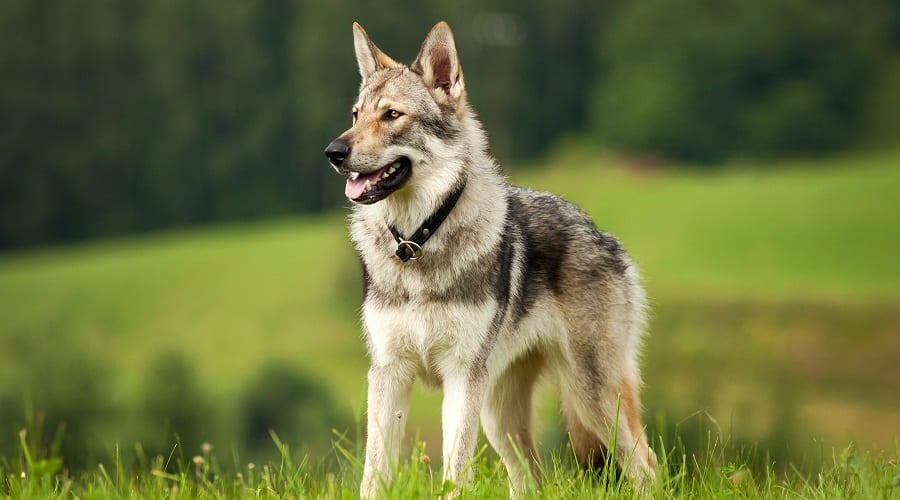
This guide explains what makes a breed “wolf-like,” why actual wolf ownership is problematic, and which 18 breeds give you that wild aesthetic without the wild behavior. Whether you are searching for a loyal companion with a wolf’s look or just exploring your options, this list will help you find the right dog for your home, lifestyle, and instincts.
Wolf-Dog History
The connection between dogs and wolves runs deep, both genetically and culturally. For thousands of years, humans have been captivated by wolves’ power, intelligence, and social bonds.
But what exactly ties today’s domesticated dogs to their wild relatives? The truth is more complex and fascinating than the traditional “dogs came from wolves” story most of us were taught.
Ancient Connections Between Dogs and Wolves
There’s a widespread belief that domesticated dogs (Canis lupus familiaris) are direct descendants of the gray wolf (Canis lupus). For a long time, the common assumption was that humans simply tamed wild wolves over time, resulting in the dogs we know and love today. But the story isn’t quite that simple.
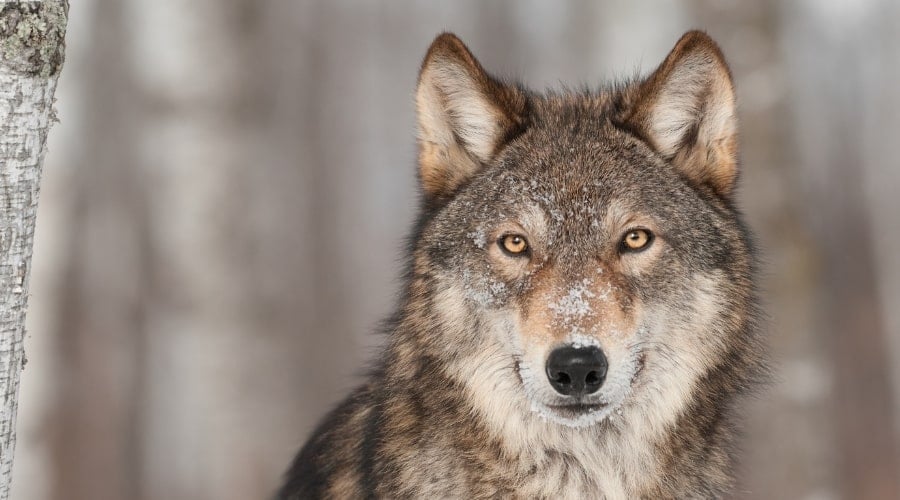
Recent research suggests that dogs and wolves are more like long-lost evolutionary cousins than direct descendants. Instead of being great-great-great-grandpups of gray wolves, modern dogs likely share a now-extinct ancestor with them, one that was domesticated somewhere between 15,000 and 40,000 years ago. Over that time, their biology, behavior, and appearance changed dramatically.
What hasn’t changed much is their DNA. Dogs and wolves are still so genetically similar that they can mate and produce fertile offspring, known as wolf hybrids. When creating wolf-like dog breeds that mirror a wolf’s appearance, that close genetic relationship allows breeders to activate or emphasize certain physical traits—like coat color, ear shape, and body structure.
Modern Fascination and Breeding Efforts
The fascination with wolf aesthetics is nothing new. Wolves have long captured human imagination, appearing in mythology, folklore, and modern media. From ancient cave art to contemporary series like Game of Thrones, wolves have been portrayed as mysterious, powerful, and noble creatures.
In response, breeders have developed specific dog breeds that resemble wolves but retain domestic trainability. Breeds like the Tamaskan, Saarloos Wolfdog, and Northern Inuit were created by combining traits from huskies, shepherds, and other northern dogs. The goal? To recreate the majestic wolf form in a companion-safe package.
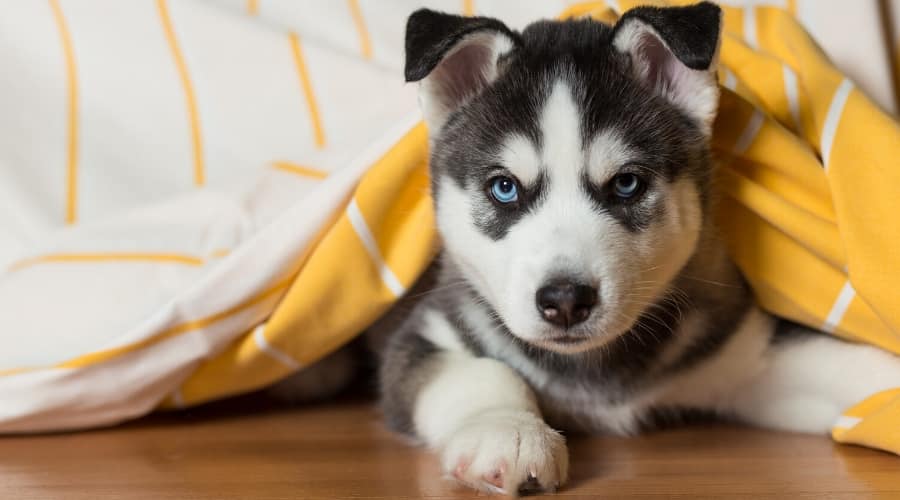
This is good news for those drawn to the look of a wolf but seeking the behavior of a companion animal. Many wolf-like dog breeds thrive in domestic environments and can adapt well to family life, especially when their needs for exercise, training, and socialization are met.
In the next sections, we’ll explore the legal and ethical implications of owning wolf hybrids and introduce you to 18 stunning breeds that channel the spirit of the wild without bringing the wild into your living room.
Many of these are great for cold weather and are easy on the eyes, too. If you need a name, you are in luck because we also have a wonderful list of wolf-dog names for you to choose from.
Wolf-Dog Breeds Legalities & Ethics
Before you fall in love with the idea of owning a wolf-dog or even a breed that closely resembles one, it’s crucial to understand the legal and ethical landscape. While some breeds are perfectly legal and domesticated, others straddle a gray area that can get owners into serious trouble.
Ownership isn’t just about desire or aesthetics—it’s about responsibility, regulations, and doing right by the animal.
What’s the Difference Between a Wolf Hybrid and a Lookalike?
A wolf hybrid (also called a wolf-dog or wolfdog) is the direct result of crossing a domestic dog with a wolf, typically a gray wolf. These animals can exhibit unpredictable behavior due to their wild genetics.
In contrast, wolf-like dog breeds like the Alaskan Malamute or Tamaskan have no recent wolf ancestry. They merely resemble wolves in appearance but are domesticated in behavior, temperament, and needs.
This video shows a brief glimpse into the life of a true wolf-dog hybrid.
State and Local Laws Around Wolf Hybrids
Laws on wolf-dog ownership vary widely. In the U.S., over 20 states prohibit owning wolf hybrids outright. Others allow them with special permits, containment requirements, or mandatory insurance.
Even where legal, landlords and homeowners’ insurance policies may refuse coverage. Always check local and state regulations before considering a hybrid.
Most of the dog breeds we cover are wolf-like dogs, not wolf hybrids. The only two breeds on this list that may count as hybrids are the Czechoslovakian Wolfdog and the Saarloos Wolfdog.
Ethical Considerations and Responsible Ownership
Keeping a wolf or high-percentage hybrid as a pet comes with serious ethical concerns. These animals require specialized care and extensive enrichment and often fail to thrive in a household setting. Many end up in sanctuaries or are euthanized due to unmanageable behavior.
Ethically, prospective owners should consider whether their desire for aesthetics outweighs the animal’s welfare and long-term well-being.
These 18 Wolf-Like Dog Breeds Could Be Your Next Pack Member
Let’s get to the bit that you’re here for: the wolf-like dogs. Here is our top list of dog breeds that look most like wolves. Some you would double-take in the forest, and some look like cute wolf dogs that are dainty enough to fit in your purse (maybe a big one, though.)
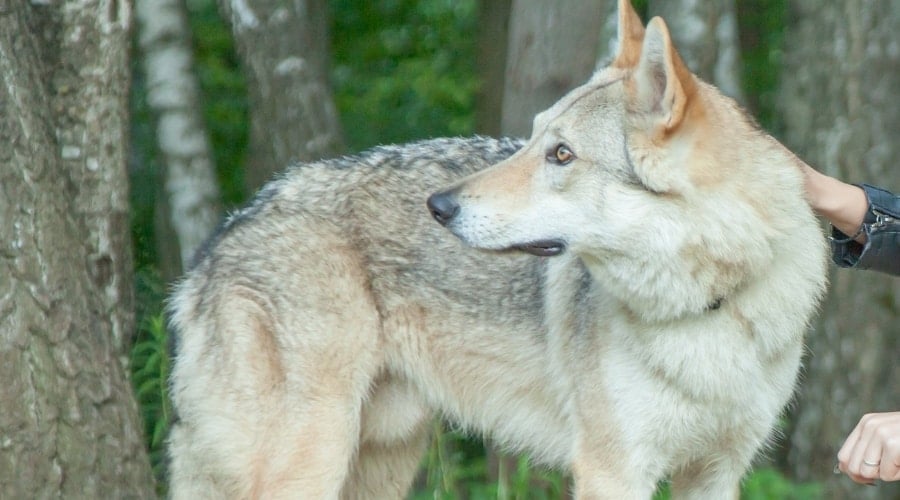
A few of these guys are wolf hybrids, which directly result from scientific experiments. However, some rely on the re-activated wolfy lookalike gene that we mentioned above. Everything you need to know about them is explained in their section, including whether they are just wolf-like or a wolf hybrid.
High Wolf-Like Appearance
These are the breeds most commonly mistaken for real wolves.
With long muzzles, upright ears, thick coats, and intense amber or yellow eyes, these dogs don’t just resemble wolves. They command attention. Some even share recent wolf ancestry. While stunning, these breeds often require experienced, active owners who understand their needs and instincts.
1. Czechoslovakian Wolfdog: Bold, Active, Needs Experienced Handlers
The Czechoslovakian Wolfdog looks a lot like a wolf. Also known as the Czechoslovakian Vlcak or the Ceskoslovensky Vlciak, he is a relatively new breed created in the 1950s by the Czech military. He was designed to be a blood-thirsty and vicious patrol dog in the Cold War.
The result was much different, and although he is vigilant and suspicious of strangers, he is more cuddly and loving, similar to his domesticated parent.

He is a German Shepherd that’s mixed with a Carpathian wolf, and to be precise, he is around 6% wolf and 94% German Shepherd. This breed is not officially recognized by the American Kennel Club just yet but is proving to be a popular companion for very active families.
He is also used in search and rescue, herding, agility, tracking, drafting, and working dog sports. This pooch is not for a first-time dog owner, and he needs 2 to 3 hours of exercise a day to be happy and healthy. But as long as you put in the hard work, this wolf hybrid is one of the closest creatures you can get to a pet wolf.
- Temperament & Energy Level: Loyal, intense, very active, reserved with strangers
- Living Needs & Grooming: Requires advanced training and socialization, minimal grooming needs
- Owner Challenges & Cost: Not for beginners, requires experienced handling and secure containment
2. Saarloos Wolfdog: Reserved, Sensitive, Not Ideal for First-Time Owners
The Saarloos Wolfdog is another wolf doppelganger, and breeders and wolf experts think that the facial expressions of the Saarloos Wolfdog are almost identical to that of a wild wolf. A Dutch breeder created him in the 1930s, and he is also a mix of wild European wolves and German Shepherds.
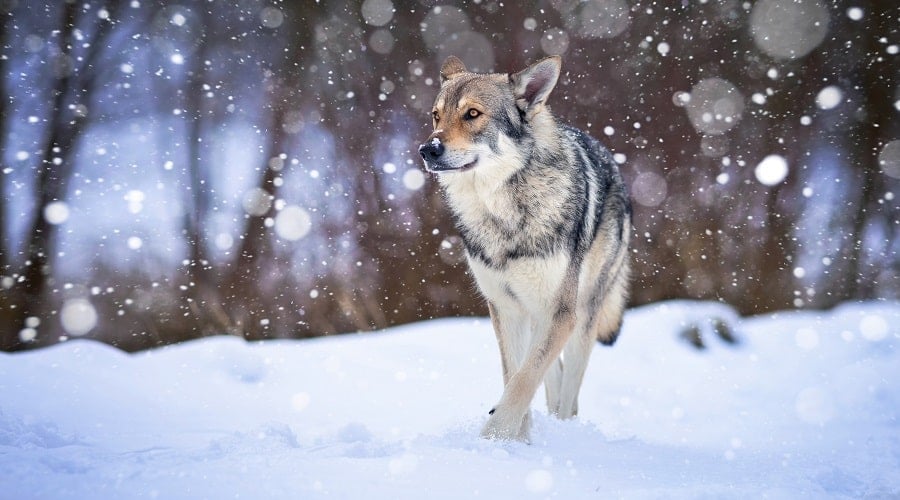
The Saarloos is a kind pooch, but he is not overly cuddly with his humans. He retains his wild instincts and prefers the company of his four-legged pack. He is also similar to wolves in that he will avoid uncertain situations and avoid contact with unknown strangers.
The Saarloos Wolfdog is friendly with his humans and likes to sit at your feet in the evening – making him perfect for those who do not like lapdogs. Again, he is not a good choice for a first-time dog owner, and he requires several hours of intense exercise to keep his body and mind happy.
- Temperament & Energy Level: Sensitive, shy, needs confidence building, moderate energy
- Living Needs & Grooming: Prefers quiet, stable environments; seasonal shedding
- Owner Challenges & Cost: Needs gentle socialization; rare breed = limited vet expertise
3. Northern Inuit Dog / Utonagan: Family-Friendly, Moderate Maintenance
Many believe that these two dogs are different breeds, but they are the same; their names simply represent different places. You might recognize these dogs if you are a fan of the hit series, The Game of Thrones.
Northern Inuits were used because they are the most wolf-like dog breeds that are friendly enough to work on set safely with children around.
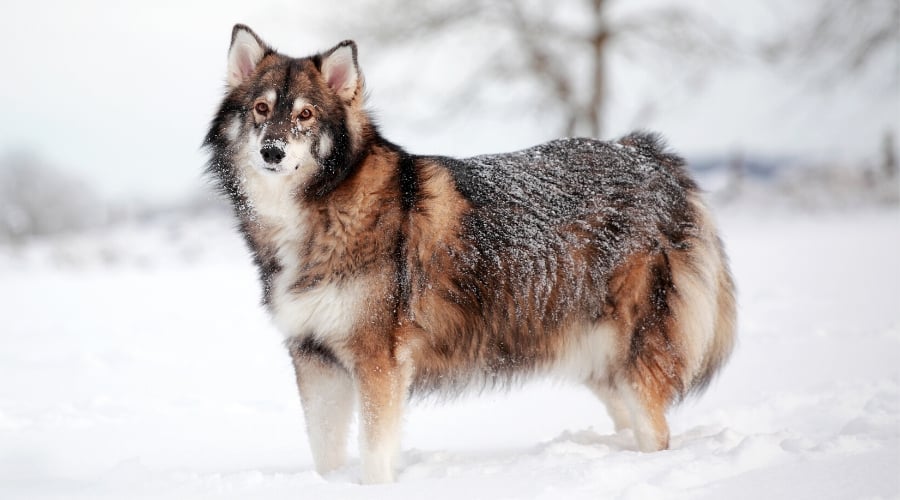
They are another new breed created in the 1980s, and it is thought that they are a mix of the Husky, Alaskan Malamute, and the German Shepherd. Owners compare their personality to that of the Husky, being energetic, friendly, and funny. If you are lucky enough to have one of these guys, they are great companions for kids.
- Temperament & Energy Level: Friendly, sociable, moderate to high energy
- Living Needs & Grooming: Needs daily activity and attention, shed heavily
- Owner Challenges & Cost: Prone to separation anxiety, grooming and feeding can be intensive
4. Tamaskan: Athletic, Loyal, Adaptable Companion
The Tamaskan is another dog breed that looks like a wolf, but there are no records of wolf blood in his line, unlike the Czech Vlcak or the Saarloos. Instead, he is a Husky and Malamute cross with some other unknown sled dogs thrown into the mix.
Tamaska means ‘mighty wolf’ in many Northern American Indian languages.
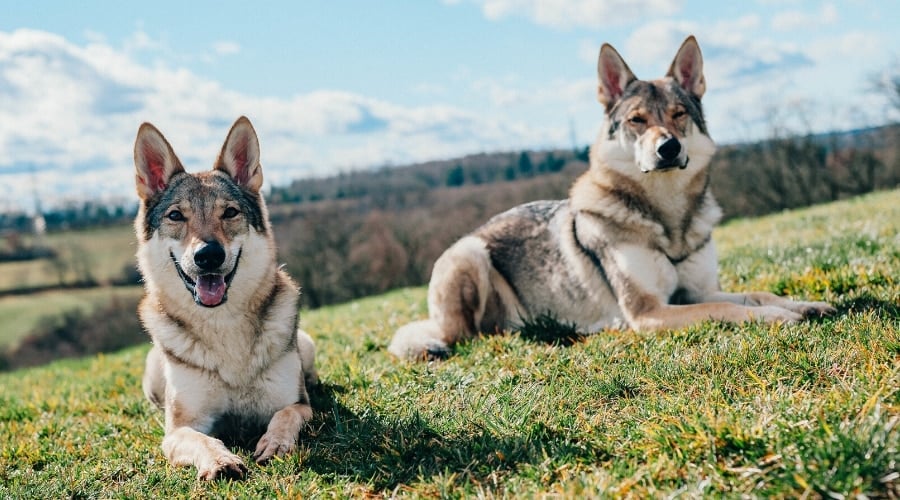
Just like the Northern Inuit, he is very similar in his personality to the Husky. So, as long as you can handle his high energy, he would make an excellent fit for your family. He is more laidback, devoted, and trainable than the Husky, so much so that he is used as a working gun dog and therapy dog.
- Temperament & Energy Level: Loyal, eager to please, playful, high stamina
- Living Needs & Grooming: Cold-tolerant, requires consistent mental and physical stimulation
- Owner Challenges & Cost: Needs time and training, not ideal for apartments, moderate cost of care
5. Kugsha: Independent, Strong-Willed, Rare Breed
The Kugsha’s history is undocumented and surrounded by confusion. What we can ascertain is that he is an Alaskan Malamute mix, possibly with wolves, but it all depends on who you’re asking. If he is mixed with wolves, it was so long ago that he doesn’t count as a wolf hybrid.
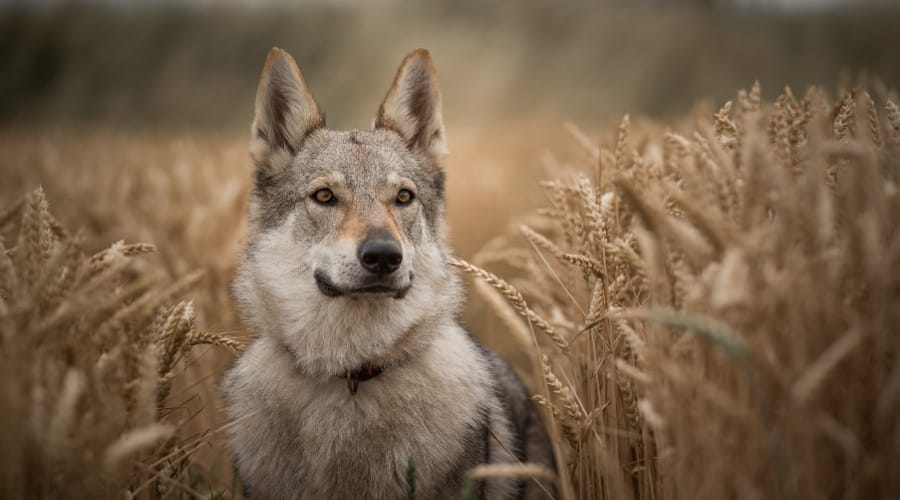
He was initially called the American Husky, but this didn’t go down well with Husky lovers. So he is now called the Kugsha or the Amerindian Malamute.
In terms of weight and size, he finds himself in between the Husky and the Malamute. Although they are independent dogs who are not easily trainable (first-time dog owners be wary), he hates to be left alone. So, if you are thinking about welcoming this boy into the family fold, someone needs to be home for most of the day.
- Temperament & Energy Level: Independent, alert, highly active and working-oriented
- Living Needs & Grooming: Prefers space and jobs, cold-weather hardy, thick coat
- Owner Challenges & Cost: Rare breed; high exercise needs, limited breeder availability
Medium Wolf-Like Appearance
These breeds carry a strong resemblance to wolves but with more domesticated traits.
They often share the same coat texture, eye shape, and body structure as wolves, but their behaviors tend to be more predictable and family-friendly. Many of these dogs were bred for working in cold, rugged environments, adding to their robust, wild look.
6. Siberian Husky: High-Energy, Playful, Vocal
When thinking about wolf-like dogs, the Siberian Husky is the first wolf-like dog that everyone thinks of. The Siberian Husky is also the most popular dog breed on this list and one of the most common family dogs, too.
He is a vocal and funny canine who loves to be the center of attention. Huskies also love to be cuddled by humans.

He originates from the cold lands of Siberia, where his purpose was to pull heavy sleds across vast icy expanses. Carrying both people and goods, this guy has stamina and strength. He has lots of energy, and if you welcome one of these guys into your life, you need to be an active family who can keep up with him.
Recently, breeders have mixed the Siberian Husky with a wolf to create what is known as the real Wolf hybrid. Although this sounds intriguing, he is more like a wild animal than a domesticated dog. Because he has a high wolf content, he is not suited to the majority of families.
- Temperament & Energy Level: Playful, intelligent, high energy, prone to vocalizing and mischief when bored
- Living Needs & Grooming: Requires daily exercise, best in cooler climates, heavy seasonal shedder
- Owner Challenges & Cost: Needs secure fencing and stimulation, moderate grooming, and vet costs
7. Alaskan Malamute: Powerful, Stubborn, Cold-Weather Hardy
The Alaskan Malamute is the Husky’s BIG brother, so big that he can be twice as heavy as the Husky. His larger body is covered in extra fluffy fur, so if you aren’t a fan of lots of dog hair, you might not want to invite this gorgeous boy into your home.
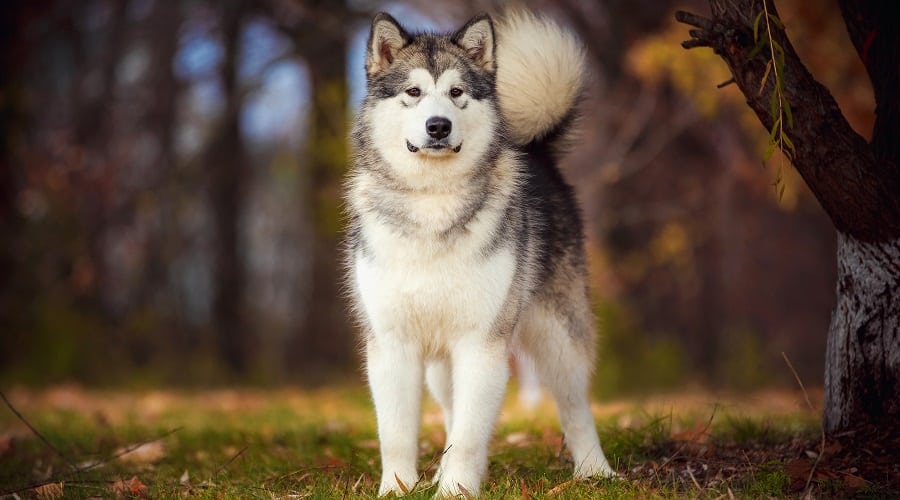
He is super cuddly and affectionate, so if you’ve ever fancied cuddling a wolf, this is probably your closest (and safest) chance. He is like the Husky but much calmer in the home, like a gentle giant.
The Malamute originates from Alaska, and the Alaskan tribes used him to pull heavy carts between tribes. This freight boy has a lot of power and energy, too, and he needs a strong leader. You need to teach him how to walk nicely on the leash if you are thinking about getting one of these guys.
- Temperament & Energy Level: Strong-willed, affectionate, very energetic, better as a solo pet
- Living Needs & Grooming: Cold-adapted, needs lots of space and activity, thick coat needs regular brushing
- Owner Challenges & Cost: Can be destructive if under-exercised, higher food and grooming expenses
8. Canadian Eskimo Dog: Working Drive, Cold-Tolerant, Needs Exercise
The Canadian Eskimo Dog is one of the rarest dog breeds in the world. It’s thought that there are less than 300 left in the world today. If you are lucky enough to get your hands on this wolf-like boy, know that you are in for a lot of love and cuddles. He is a sled dog by day and a family hot water bottle by night.
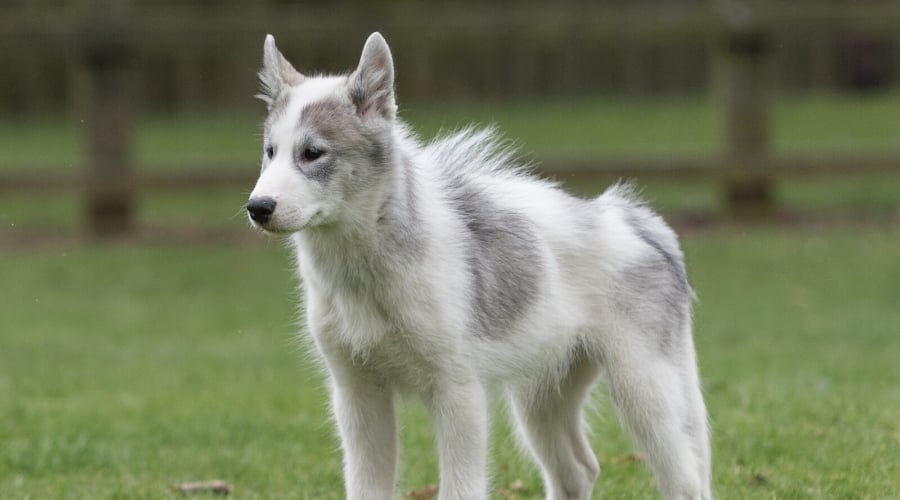
He can weigh up to 105 pounds if not used as a working dog. This breed can be bigger than the giant Alaskan Malamute. You can often tell him apart from a Malamute simply by the color of his eyes because they are any color apart from blue. With his yellow eyes, he looks very wolf-like.
- Temperament & Energy Level: Strong work drive, bold, high stamina
- Living Needs & Grooming: Performs best in outdoor, colder environments; dense coat
- Owner Challenges & Cost: Rare; not suited to novice owners; strong prey drive
9. Shikoku: Reserved, Agile, Primitive Instincts
The Shikoku is a Japanese dog breed, which is also known as the Kochi Ken or the Japanese Wolfdog. This is because his head looks similar to a wolf’s head, and he used to live in the mountains of Japan hunting wild boar and other game.
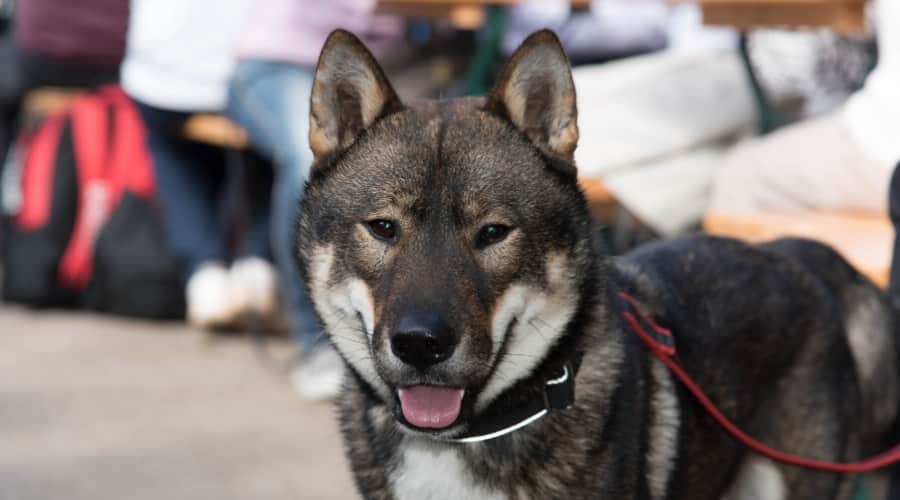
He has similar face mask patterns to the Arctic sled dogs, and his coat is similar, too. The main differences are his curly Akita-like tail and smaller pointy ears. He is now commonly found in family homes, completing his rounds as the family guard dog. He is alert, enthusiastic, and happy to snuggle in the evening after a hard day’s work protecting his family.
- Temperament & Energy Level: Reserved, alert, agile; cat-like independence
- Living Needs & Grooming: Moderate space needs, moderate coat maintenance
- Owner Challenges & Cost: Needs socialization; may challenge owner authority
10. Seppala Siberian Sleddog: Driven, Pack-Minded, Endurance Focused
The Seppala Siberian Sleddog was once labeled the Siberian Husky. But after several decades of further breeding, he is now a separate breed altogether. Seppalas have longer legs and a leaner body, and their ears are taller and set closer together, giving them a wilder wolfy look.
Many people refer to these guys as the working Huskies the Siberian Huskies are sometimes called the show dogs.
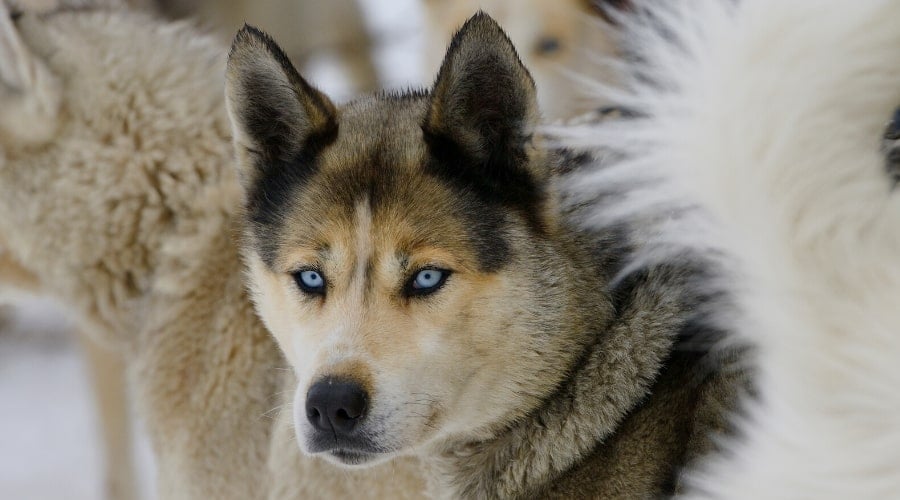
Seppalas have very similar personalities to Husky but have a hard-working ethic. He is just as energetic and has the exact same exercise needs, but he is much calmer at home. This is a significant appeal of his, and many families find him more relaxing to be around.
- Temperament & Energy Level: Driven, focused, very active
- Living Needs & Grooming: Needs consistent work or structured activity, minimal grooming
- Owner Challenges & Cost: Demands work or purpose; can be bored and restless in family homes
11. American Alsatian: Laid-back, Wolf Appearance, Family-Oriented
The American Alsatian is also a derived dog breed from the German Shepherd. This is what many would consider the “American version” of the German Shepherd dog. These dogs are typically leaner and taller than normal German Shepherds. These pups can weigh upwards of 90-100 pounds when fully grown.
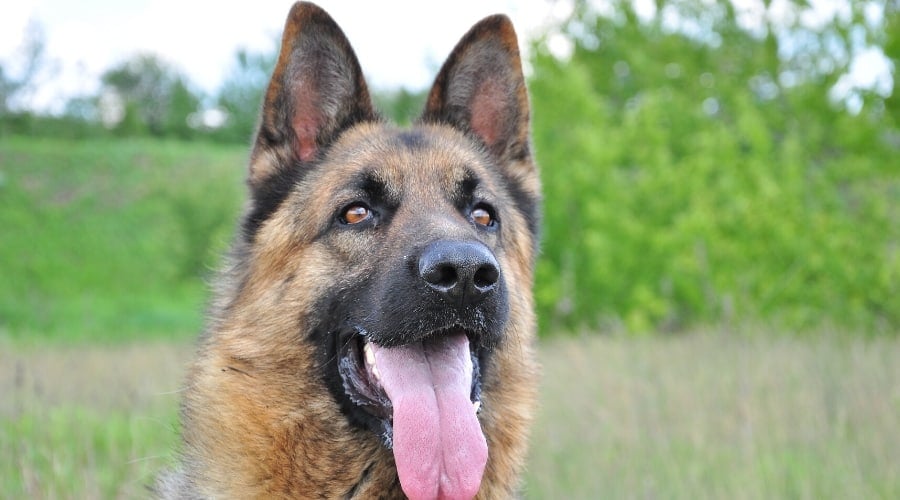
The American Alsatian breed was achieved by initially crossing the German Shepherd and Alaskan Malamute. From there, other breeds were introduced, including the Great Pyrenees and the Anatolian Shepherd, to name a few. This gave the Alsatian some added size.
Alsatians can have shorter coats but can also have longer coats as well, depending on their genetics. Their eyes tend to be amber in color, adding to their wolf-like appearance.
- Temperament & Energy Level: Quiet, loyal, calm indoors
- Living Needs & Grooming: Low exercise needs; heavy seasonal shedding
- Owner Challenges & Cost: Rare breed; health screening important, grooming-heavy
Subtle Wolf Features
These dogs have a touch of the wild, but it’s more in the details.
Whether it’s a pointed muzzle, upright ears, or a thick, weather-resistant coat, these breeds may not be mistaken for a wolf at a glance, but they definitely carry traces of that ancient ancestry. They tend to be more adaptable, trainable, and well-suited for families or first-time owners.
12. German Shepherd: Trainable, Protective, Versatile
The German Shepherd is a well-known doggy in the canine world and a popular dog breed in America. His standard coat and colors aren’t similar to the wolf’s, but he has rarer colors, such as pure white, pure black, and, less commonly, blue.
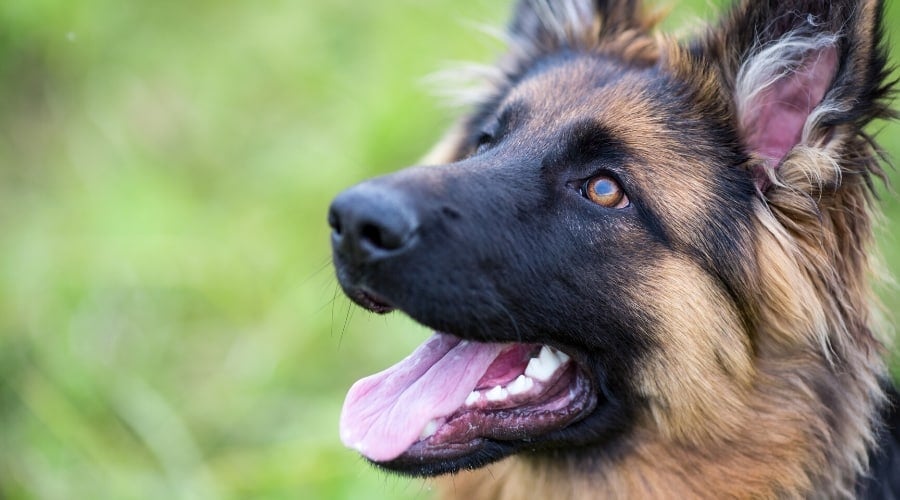
German Shepherds have the same wild-looking face and frame, and he is used in many wolf crosses because of his trainability, human loyalty, and re-activating wolf genes. Some people say that the longer-haired German Shepherds look quite a bit like a wolf you’d find in the wild.
He is an intensely energetic and intelligent dog who needs to be placed with a family that can spend a lot of time with him. It’s also essential to invest in plenty of toys and brain games to keep this boy’s smart brain stimulated. If you are looking for a wolf-like guard dog, this is your breed.
- Temperament & Energy Level: Loyal, protective, highly trainable, high drive
- Living Needs & Grooming: Adaptable, benefits from tasks and obedience work, moderate grooming
- Owner Challenges & Cost: Hip issues are common; high vet bills are possible
13. Swedish Vallhund: Small But Mighty, Energetic Herder
Have you ever wondered what a Corgi and a wolf mix would look like? Wonder no more, reader, because the Swedish Vallhund is precisely what their puppy would look like. This cute little wolf-like pooch stands up to 14 inches tall, and he is the shortest on this list. If you are after a mini-wolf, look no further than this guy.

This Viking dog of the ancient legend dates back some 1,200 years ago. The Swedish Vallhund is a herding dog, just like the Corgi, and uses the same ankle-nipping technique. He loves to play with his family when he is not bossing cows around.
He loves every minute of life, and he always has a smile on his face. This cute and cuddly pooch makes a great addition to active families and those with children.
- Temperament & Energy Level: Spirited, vocal, herding instinct, moderate energy
- Living Needs & Grooming: Does well in smaller homes, needs daily play, sheds seasonally
- Owner Challenges & Cost: May bark excessively; grooming is easy but regular
14. Samoyed: Friendly, Vocal, Heavy Shedding
The Samoyed is a heavenly canine cloud that loves to cuddle. He is another ancient sled dog who can pull one and a half times his weight. He cuddled his human pack during the freezing nights to keep them warm, which is why their love of humans is so strong. This is also why he makes a great family companion today.
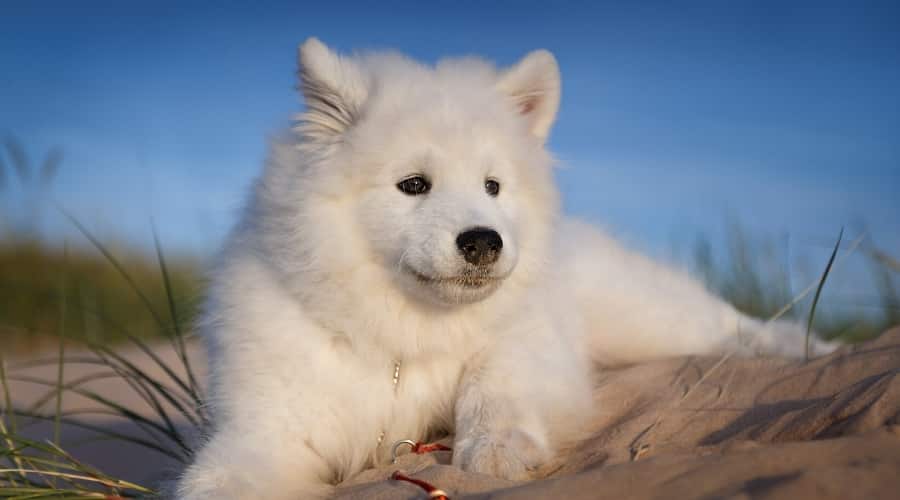
The Samoyed is very similar looking to the wolf, but his coat is much fluffier. If you aren’t a fan of the remnants of a white coat on your outfit or furniture, this boy is not for you because he is a heavy shedder. Thankfully, the sides of his mouth turn upwards to prevent drooling, so except for his hair, he is a clean pup.
- Temperament & Energy Level: Cheerful, sociable, moderately active, affectionate
- Living Needs & Grooming: Needs brushing several times a week, cool climates preferred
- Owner Challenges & Cost: Heavy grooming burden, may not tolerate heat well
15. Finnish Lapphund: Social, Adaptable, Family-Oriented
The Finnish Lapphund is an obvious Nordic breed with its fluffy exterior and Spitz-like face. He is also wolf-like in appearance, and his head and coat are very similar, albeit in a smaller stature. His breed has a strong startle reflex, which remains from his wild days.
So be careful when you wake him because he might jump and snap.
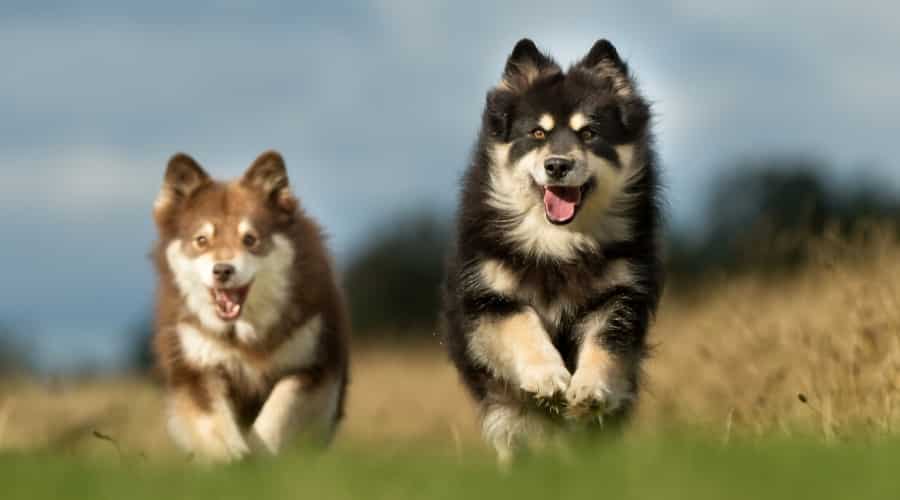
He is swift and agile, making him a fantastic agility course participant. This is great if you plan to show off how smart and obedient your pooch is. Finnish Lapphunds are very loving with their family but wary of strangers. He prefers a quiet, cuddly life with his family and doesn’t like to be the center of attention.
- Temperament & Energy Level: Calm, gentle, good family dog, medium energy
- Living Needs & Grooming: Comfortable indoors with daily walks; dense double coat
- Owner Challenges & Cost: Moderate grooming needs; sensitive to heat
16. Caucasian Shepherd: Massive, Guardian Instincts, Not for Beginners
The Caucasian Shepherd originates from Russia and is often referred to as the Russian Bear Dog. These furry beasts are a very furry wolf-like dog breed, and a large part of that is due to their long, fluffy coat.
They are hardy dogs, bred to stand up to some of the most punishing cold mountain weather conditions.
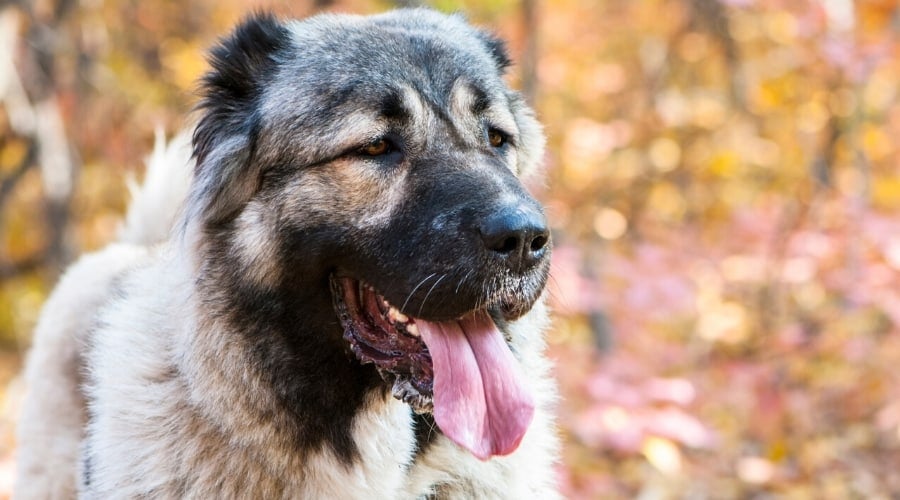
These dogs are largely used as guardian dogs and are protectors of their flock. They are used on farms and thrive best in cooler climates. Caucasian Shepherds need plenty of room to roam, and males can be both stubborn and protective.
These pups are not recommended for first-time dog owners and require firm leadership during puppyhood.
- Temperament & Energy Level: Protective, dominant, low-moderate energy
- Living Needs & Grooming: Requires space, secure property, thick coat
- Owner Challenges & Cost: Not for beginners, expensive to feed and vet, aggression risk if not trained early
17. King Shepherd: Gentle Giant, Trainable, Protective
King Shepherds are a rarer breed, and they have similar genetic lines to the German Shepherd. Their parents are the German Shepherd and the Shiloh Shepherd. The King Shepherd was created to make a much larger version of the German Shepherd and has proven to be popular.
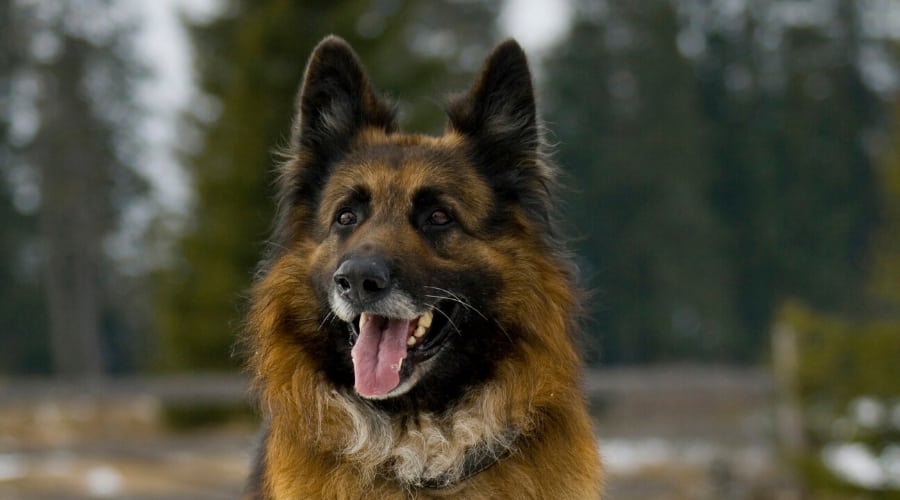
Breed health was also a factor, as backyard breeding has become popular, producing genetic defects in purebred German Shepherds. Introducing the Shiloh Shepherd to create the King Shepherd was aimed at a larger, stronger breed and a healthier one with fewer genetic defects.
King Shepherds will almost always have long hair. This headstrong breed may even look more like a wolf than their German Shepherd parent.
- Temperament & Energy Level: Calm, family-friendly, intelligent
- Living Needs & Grooming: Needs regular brushing and moderate exercise
- Owner Challenges & Cost: Prone to joint issues; moderate grooming and food costs
18. Shiloh Shepherd: Calm, Intelligent, Low Reactivity
Similar to the King Shepherd, the Shiloh Shepherd was originally bred to create a larger line of the German Shepherd. Breeders accomplished this by mixing in the lines of an Alaskan Malamute.
Later on, they actually introduced the Canadian White Shepherd and the Czechoslovakian Wolfdog (another dog on this list) to breed additional genetic diversity for health reasons.
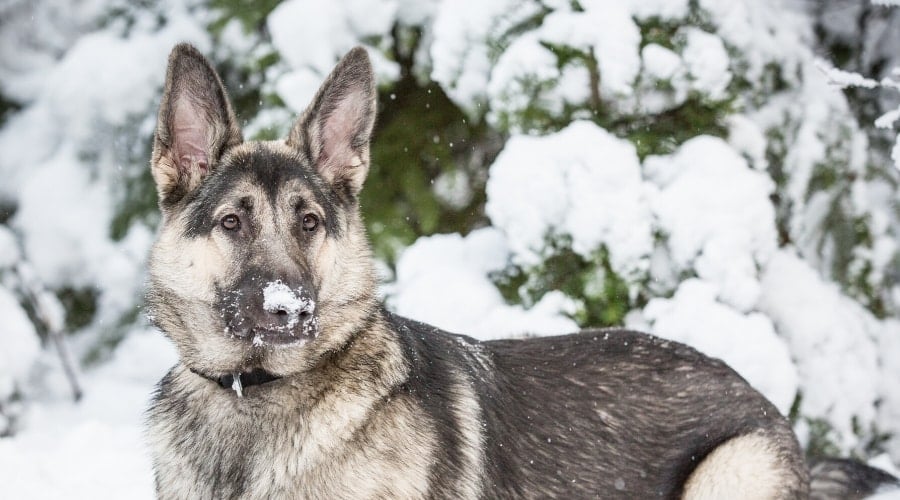
The Shiloh Shepherd looks in many ways like a regular German Shepherd, just bigger. They can have longer or shorter coats and are not officially recognized by the AKC. It’s worth noting that longer and fluffier coats are typically the norm.
They should have plenty of room to roam if you plan to bring one home. They are more docile and have lower energy levels than standard German Shepherds, making them a good fit for families.
- Temperament & Energy Level: Gentle, stable, trainable; good with children
- Living Needs & Grooming: Daily walks and brushing required
- Owner Challenges & Cost: Prone to bloat and hip dysplasia; moderate expense
Training & Socialization Tips
Wolf-like dog breeds may look wild, but living with one shouldn’t feel like taming a wild animal. These dogs often carry strong instincts—intelligence, independence, prey drive—that make training essential from day one. Whether you’re bringing home a high-energy sled dog or a more reserved shepherd type, proper training and early socialization are what transform these striking breeds into loyal, well-adjusted companions.
Why Early Training is Critical
Wolf-like dog breeds often retain strong instincts like prey drive, independence, and territorialism. Early training, starting in puppyhood, is essential to create boundaries, reduce behavioral issues, and reinforce pack hierarchy.
Socialization should begin as early as 8 weeks and continue well into adolescence to avoid fear or aggression later.
Working with High-Energy, Pack-Oriented Breeds
Many wolf-like breeds, such as the Siberian Husky or Czechoslovakian Wolfdog, were bred for endurance, hunting, or sled work. Without physical and mental stimulation, they can become destructive or escape-prone. Structured play, obedience classes, agility training, and jobs like canicross or scent work help redirect energy and maintain emotional balance.
First-Time Owner Advice
Not all wolf-like dog breeds are suitable for first-time dog owners. Some breeds demand experience, consistency, and confident leadership. Before committing, new owners should assess their time, energy, and ability to train a high-maintenance breed. For beginners, more adaptable breeds like the Finnish Lapphund or German Shepherd may offer a better starting point.
Frequently Asked Questions
Choosing a wolf-like dog breed comes with plenty of questions, especially when it comes to behavior, legality, grooming, and ownership challenges. Below, we’ve answered the most common and important questions to help you make an informed, confident decision before bringing one of these majestic dogs into your life.
If we missed yours, or you have experience to share, let us know in the comments.
What Is The Most Wolf Like Dog Breed?
The most wolf-like dog breed is the Wolfdog hybrid, a cross between a Gray Wolf and a domestic breed like a Siberian Husky or Alaskan Malamute.
These animals are controversial and not considered domesticated in the traditional sense. They urinate and defecate inside, are not easy to train, and will not hesitate to bite if they think someone is trying to take something away from them.
- Behavior & Temperament: Wolfdogs often retain wild instincts. They are territorial, dominant, difficult to train, and may act aggressively when resource-guarding.
- Size & Needs: Adults can weigh up to 155 pounds. They require multiple hours of outdoor time daily and need at least one acre of secure, reinforced land.
- Ownership Challenges: They are expensive to feed, difficult to socialize, and unsuitable for families or novice owners.
- Legal Status: Heavily regulated or banned in many states. Most places only allow hybrids past the fifth generation, and even those may retain unpredictable behavior.
Despite their mystique, Wolfdogs require expert-level care and are not recommended as pets for the average dog lover.
Are There Wolf-Like Dog Breeds That Don’t Shed?
Unfortunately, no. Wolf-like dog breeds are known for their thick, double-layered coats, which are built for harsh weather and come with significant shedding.
- All the breeds on this list shed moderately to heavily, especially during seasonal changes (spring and fall).
- Regular brushing, grooming, and vacuuming are essential for managing fur and maintaining coat health.
- If shedding is a dealbreaker, consider a different breed category entirely; there are no hypoallergenic or low-shed wolf-like breeds.
How Can You Tell If a Dog Has Wolf Ancestry?
Physical appearance can hint at wolf heritage—such as a long muzzle, upright ears, and amber eyes—but the only reliable method is a DNA test. Companies like Embark or Wisdom Panel offer canine genetic testing that can detect wolf content and hybrid ancestry.
Do Wolf-Like Dog Breeds Howl?
Yes—many do. Breeds with northern or primitive roots (e.g., Huskies, Malamutes, Tamaskans) are prone to howling, especially when left alone or when they hear sirens, music, or other dogs. It’s part of their communication instincts, and it’s something owners should be prepared for.
What Should I Feed a Wolf-Like Dog Breed?
These breeds often have high protein needs due to their energy levels and working backgrounds. A diet rich in animal protein (30% or higher), healthy fats, and joint-supporting supplements like glucosamine is ideal. Some owners opt for raw diets, but it’s best to consult a veterinarian or canine nutritionist.
Do These Breeds Do Well in Hot Climates?
Most wolf-like breeds were developed for cold or temperate climates, and many struggle in heat due to their dense double coats. If you live in a warm region:
- Provide constant shade and water
- Limit exercise to early morning or evening
- Consider trimming—not shaving—the coat
How Long Do Wolf-Like Dog Breeds Live?
Lifespan varies widely by breed and health background:
- Large breeds like the Caucasian Shepherd: 8–10 years
- Medium breeds like the Tamaskan or Husky: 12–15 years
- Crossbreeds like the American Alsatian: 10–13 years
Regular vet care, proper nutrition, and mental stimulation can all extend life expectancy.
A Wolfy Word Of Warning
First, keep in mind that the increasingly popular desire to welcome a wolf-like dog into our homes brings the rise of irresponsible breeders. Dodgy breeders will claim to have domesticated wolves, rare wolf hybrids, or high-content wolf dogs for sale. When in reality, they are probably just one of the wolf-like dogs listed above. So, don’t fall for their lies and pay above what you should.
Secondly, the famous Game of Thrones series has been blamed for popularizing the idea of a pet dire wolf, and people rushed out to get their hands on a wolf-hybrid. The puppy stages seem okay, and then when they hit their adolescent stage, things change. Families quickly realized they were nothing like domesticated dogs. Most families cannot cope with wild animals, and they then surrender them to wolf-hybrid sanctuaries.
If you are still convinced that you want a wolf hybrid rather than a wolf-like dog, please do some more research before you get one and add to the wolf hybrid sanctuary problem. They are not like domesticated dogs at all, and they are not suited to the vast majority of families. Don’t expect fluffy cuddles, walks, or anyone to be willing to dog-sit them while you go on vacation.
Not Just Wolves: What About Fox or Coyote-Like Dogs?
While wolf-like dog breeds get most of the spotlight, some pups resemble other wild canines too. Fox-like dogs tend to have smaller, agile frames and bright red or fawn coats. Coyote-like breeds often have leaner bodies, longer legs, and alert expressions. Our guides to dogs that look like coyotes and fox-like dog breeds explain more.
Responsible Ownership Starts Here
Wolf-like dog breeds are captivating for a good reason: their striking appearance, intelligence, and loyalty echo the spirit of their wild ancestors. But with that beauty comes responsibility. These dogs are often misunderstood, misidentified, or unfairly labeled as aggressive due to their wolfish looks.
As a potential or current owner, it’s your job to shift that narrative through proper training, socialization, and care. Whether you’re drawn to a Husky, Tamaskan, or Saarloos Wolfdog, remember that these are not fashion statements; they’re intelligent, sensitive animals that require leadership, structure, and lifelong commitment.
Do your research. Respect their instincts. Train with patience. And above all, be the kind of owner who elevates the reputation of these incredible breeds.
Ready to find the right wolf-like dog for your pack?
Explore the breeds above, read real owner experiences, and check local regulations before choosing. Responsible ownership starts with informed decisions, start yours today.



